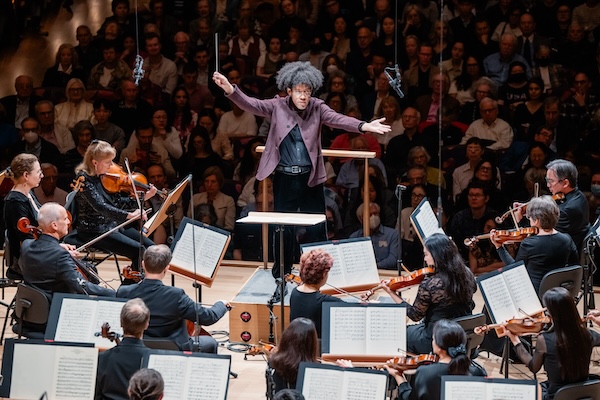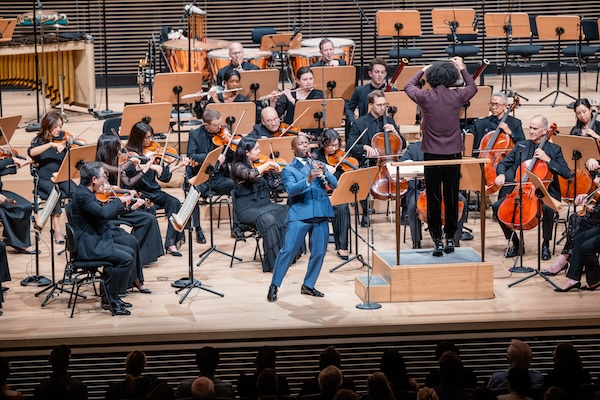Despite some rough edges, Payare’s return pays off with Philharmonic

Rafael Payare, the very model of a modern multiple music director, had successes here last year with his Montreal Symphony Orchestra and his San Diego Symphony.
Wednesday’s concert of works by Gubaidulina, Mozart and Tchaikovsky with the New York Philharmonic showed what the Venezuelan-born conductor with the controlled but dynamic podium style could achieve with musicians who were not his week-in, week-out collaborators.
At 44, Payare still gives off a youthful aura that recalls his roots in Venezuela’s fabled program for young musicians, El Sistema. Economical of gesture with his own orchestras, he approached the Philharmonic on Wednesday in a more explicit, hortatory manner that stayed just clear of micromanaging.
Sofia Gubaidulina’s Fairytale Poem, an early (1971) example of her distinctive, fantastic orchestral sound, was based on a Czech tale about a piece of chalk, bored with its life writing numbers on a school blackboard and dreaming of drawing oceans and sunsets, all while becoming smaller and smaller from use. With unusually prominent parts for piano and vibraphone, the composer generated a characteristically Czech atmosphere of gloomy pessimism mixed with wonder at nature’s beauty.
Payare gently summoned swirling vibraphone clouds and piano water drops, eerie woodwind shivers over skulking pizzicato cellos, and finally warm and playful violins as the bit of chalk got its wish at last before vanishing, pianissimo.
Clarinetist Anthony McGill, familiar to Philharmonic audiences from his principal’s chair in the orchestra, was greeted with prolonged applause as he came on stage to play Mozart’s Clarinet Concerto. Payare and the orchestra didn’t treat him so kindly at first, giving a rather perfunctory reading of the first movement’s exposition and not making enough sonic space for the soloist at his entrance. That, and an overall feeling of haste, inhibited the suave Mozartean delivery McGill was aiming for. By mid-movement however, the clarinetist’s fluid runs were coming through clearly, and his lyricism and good cheer led the way in the recapitulation.
In the Adagio, McGill’s fine legato and lean, woody tone avoided sentimentality, and his sustained pianissimo at the main theme’s return was breathtaking. Both soloist and orchestra played the finale’s jaunty theme a little out of time, robbing the dancing tune and later soloist-orchestra repartee of some of their impact. But witty variations of the rondo theme and a brilliant coda brought it all to a successful conclusion.
Called back repeatedly to the stage, McGill obliged with an encore, “Amazing Grace,” unaccompanied and rich in gospel-style melismas.
For the concert‘s second half, Payare changed from a brown suit to a black velvet one, signaling the seriousness of the work ahead, Tchaikovsky’s Symphony No. 6, “Pathétique.” The bassoon’s deep growl was an ominous prologue, and the ensuing Allegro was appropriately agitated, if not perfectly together despite Payare’s clear beat. The second theme swelled hopefully in the violins, only to be blown away as catastrophe arrived in the movement’s development.
Although the conductor failed to keep the Philharmonic’s enthusiastic brass from covering the strings in forte passages, his delicate handling of the second theme’s wistful return and the chorale-like coda was masterly.
The dancing second movement was secure in its off-kilter 5/4 meter, and the violins gave a nice push to the graceful first theme, but blurring the second theme’s dotted rhythm took some of the dance out of it. In the scherzo’s eager triplets, the orchestra achieved the crisp ensemble that had eluded it in the first movement. Slightly broadening the triumphant march tune in its last, super-fortissimo return was a smart choice.
Payare silenced the almost inevitable applause following this thrilling movement by diving directly into the Adagio lamentoso finale. It was a pity to lose those first few bars in the commotion, but soon enough one could appreciate the strings’ soft attack and luscious shaping of their sad phrases. As they emerged from the bassoon’s murky depths, countermelodies in the brass masked them for a time, but they remained the movement’s tragic protagonist to the dark, pppp coda.
